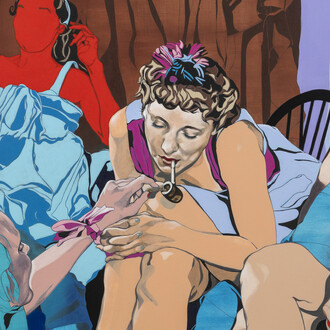This autumn the Rijksmuseum presents a major exhibition on domestic life in the 1600s, the time of Rembrandt, Vermeer and Frans Hals. At home in the 17th century offers an intimate glimpse into the everyday lives of families, parents and children from all walks of life more than three centuries ago. Designed by the Dutch artist Steef de Jong utilising cardboard, the 9 diorama-style galleries in the Philips Wing will offer visitors an immersive experience to follow 17th-century home life over the course of an entire day – from early morning till late evening. The exhibition presents highlights from the decorative arts alongside objects that were found in every household. The centrepieces of the exhibition are the famous doll’s houses belonging to Petronella Oortman and Petronella Dunois.
The exhibition At home in the 17th century is made possible by Rijksmuseum Friends, Stichting Zabawas, Stichting Thurkowfonds and via the Rijksmuseum Fonds: Fonds Dirk Jan van Orden, Lucy en Bas van der Vlist Fonds, Sara Geertruida Aalders-Huender Fonds, Fonds Sascha Ladenius and a private donor.
The doll’s house of Petronella Oortman. Unlock the secrets of a model home online
To mark the public opening of the exhibition on 17 October, the Rijksmuseum will additionally launch a new interactive online experience bringing unprecedented detail of the doll’s house to art lovers worldwide – through the inimitable voice of the British actor Helena Bonham Carter. Bonham Carter guides visitors through this extraordinary miniature world, bringing the 17th-century masterpiece to life, uncovering its hidden spaces, from the library to the cellar. The experience offers an intimate glimpse into the craftsmanship and imagination behind Oortman’s doll’s house, allowing audiences everywhere to step inside one of the Rijksmuseum’s most enchanting works — without leaving home.
Oortman's Doll’s house (ca. 1686 - ca. 1710) was already famous as a work of art in the 17th century, never intended as a toy for children. Today, it serves as a valuable resource that provides deep insight into life in the 17th century. Every detail, every object, and every painting is meticulously crafted to resemble a real house. From scissors to sewing kits, and from mousetraps to the toilet. Nowhere else does daily life in a seventeenth-century household feel so tangible. The doll’s house rightly takes a prominent place in the exhibition.
At home in the 17th century
The exhibition zooms in on the lives of a variety of people, such as the Boudaen Courten family from Zeeland province. Many items belonging to members of this family have survived, including gilded furniture, portraits and one very remarkable relic: a bladder stone retrieved in a major medical procedure. All these objects will be on view together for the first time in centuries. We also take a peek into the world of the Utrecht artist Joachim Wtewael. In 1628 he painted a portrait of his daughter Eva, seated at a table that still exists. The painting presents Eva as the epitome of the ideal housewife, with a sewing cushion on her lap and a prayer book on the table. This vision of her future unfortunately never became reality. She died seven years after the completion of the painting and never married. The painting will be on show together with the table and the matching linen cupboard.
Cesspits
The exhibition takes a multifaceted look at how people lived in the 17th century. Together with Archeologie West-Friesland, the curators have studied the contents of the 17th-century cesspit at the home of the mayor of Hoorn and his family, the Soncks. The cookware, the crockery and the food waste tell us the story of what was on the family dining table, offering detailed insights into their eating habits. Cesspits found on Vlooienburg island in Amsterdam, by contrast, reveal that Portuguese immigrants to the city brought with them their own earthenware, and their own flavours.















